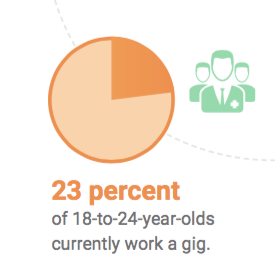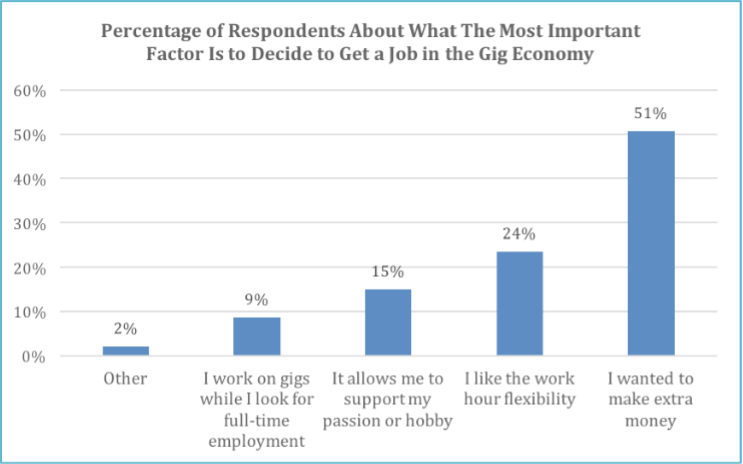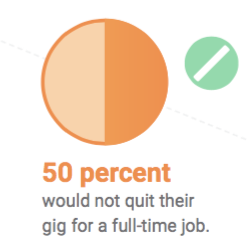Is Gigging The New American Workforce?

The gig economy — employees working in short-term, ad hoc positions and the companies employing them — is BOOMING. According to the inaugural PYMNTS Gig Economy Index™, more Americans are working gig jobs than ever before. Like 23 percent of all 18-to-24-year-olds. More than 300 new data points that shed a whole new light on this new labor force and fill important gaps that the government isn’t measuring. That, along with insights from gig workers themselves and an interview with Breanden Beneschott, COO and cofounder of Toptal, a gig entity for elite software developers, can all be found inside this index.
According to the latest research in the inaugural PYMNTS.com Gig Economy Index™, younger employees are slated to change jobs four different times during their first 10 years after graduating from college, compared to their parents’ generation, which changed jobs just twice in the same span.
But it’s not only the number of jobs that are changing; the type of work these jobs entail is shifting as well. More and more, American employees are opting to take on “gigs,” or ad hoc jobs where people provide a service over a period of time or on-demand. As the index reports, just over 10 percent of Americans worked gigs in 2005, but that number quickly grew to 15.8 percent by 2015, with an increase of 9.4 million workers taking on gigs.
The surge in workers looking for these short-term employments comes as no surprise to Breanden Beneschott, cofounder and COO of Toptal, which offers freelance software engineers and designers to companies in need of freelance talent. In a recent interview, Beneschott told PYMNTS that he expects the gig economy to continue to grow as more employees embrace the benefits of “gigging,” including increased flexibility and control over their schedule.
“I think this is the start of something big,” Beneschott said. “The whole gig economy is riding on a lot of different economic trends, and employees and companies are benefiting from this.”
 Making the right connections
Making the right connections
Toptal is what’s known as a “gig entity,” a service provider that helps connect workers to customers, working largely in the software development space, similarly to Fiverr or Upwork. Many gig employees find a job and clients through service providers like Toptal.
The company seeks to differentiate itself and its workers by representing only the top 3 percent of thousands of applicants per week to the service, a percentage that has been decreasing steadily, according to Beneschott.
The inspiration for the company came from a conversation with his cofounder and the company’s CEO, Taso Du Val. Beneschott was looking to hire new software designers as part of a team he was assembling but was having problems finding the right people. He eventually found a good fit for his team after receiving a recommendation from Du Val for a designer living in Argentina.
He said the experience opened his eyes and gave him the idea to build a service that would connect top developers with companies looking for their services, a task that is especially challenging in Silicon Valley.
“Finding good people in Silicon Valley is extremely difficult,” he explained. “It’s expensive. Everyone is already taken. They’re working at Uber or SpaceX or Facebook or Google. So, it’s extremely competitive, [with] a lot of companies competing for the same limited number of people. So, we saw an opportunity there.”
While hiring can be tough in Silicon Valley, Beneschott also noted that operating a gig entity platform such as Toptal comes with its own complications. He said that the company has a tremendous amount of overhead costs and tasks, including screening potential employees to determine how qualified they are via aptitude and personality tests, among other traits.
“The operational processes at Toptal have to be able to accommodate this kind of complexity but also accommodate that scale,” he explained. “So, when we’re screening thousands of people a week in a complex, crowdsourced screening process, there’s a lot of moving parts.”
Upping flexibility while relieving administrative hassles
While finding the right employees presents plenty of headaches for Beneschott and his team, he said that removing administrative difficulties is key to attracting the right kind of gig employees.
As the Gig Economy Index research indicates, many gig employees look for gigs as a way to increase their flexibility (24 percent) or to support a passion or hobby (15 percent).
Beneschott’s experience since launching Toptal in July 2010 largely matches what our research indicates. He noted that many of the most talented employees available are looking to increase their flexibility and take more control of their scheduling, allowing them to spend more time traveling or with their families.
However, that desire for flexibility can also be one of the biggest pain points for those in the gig economy, Beneschott explained. While most gig employees enter the space hoping they can have a better work-life balance, many find themselves bogged down with administrative work, such as invoicing, billing and having to follow up again and again (and sometimes again) to ensure they actually get paid.
“It’s very difficult to manage all of that as an individual,” Beneschott explained. “You have to find your own clients and market yourself, invoice and bill and do all the administrative work that you don’t actually get paid for.”
Index research backs up Beneschott’s statements. While more than 40 percent of respondents to PYMNTS’ survey indicated that they like the gig lifestyle and plan to keep gigging, the biggest barriers to gig work remain the speed of payment and the issues that surround it. Seventy-seven percent of gig employees said they would do more gig work if they could be paid faster and more reliably.
To attract the best talent possible, Beneschott and his team look to take those complications away from gig employees by connecting them with reliable companies and ensuring that the employees are always paid on time, he said. He added that, while most companies can be counted on to hold up their end of the bargain and make payments according to schedule, offering that insurance is a major boon for gig employees.
 A bright future, full of gigs
A bright future, full of gigs
Like the index research indicates, Beneschott said that he expects the gig economy is here to stay and will grow even larger, based on a few different economic trends. Some projections account for the gig economy to both reduce unemployment time for more than 250 million people and add more than $2.7 trillion to the GDP by 2025 as more companies and employees alike embrace the gig economy, he noted.
“A lot of really great people are increasingly looking for flexibility in their work, and a lot of them are finding it via the gig economy,” he said. “I see that happening more and more every single way with our clients and within the whole ecosystem, from startups to large companies, and I don’t see that changing.”
The change is under way. What remains to be seen is whether actual careers, for millions of Americans, can reliably be built from gigs within the gig economy. Could this be the burgeoning of a new gig-based American dream?
TO DOWNLOAD THE Q3 2016 GIG ECONOMY INDEX, A HYPERWALLET COLLABORATION, FILL OUT THE FORM BELOW:
About The Index
The PYMNTS.com Gig Economy Index™, a Hyperwallet collaboration, is designed to better understand workers in the gig economy — people who often work in short-term, ad hoc positions — who they are, what services they supply and what percentage of their overall income the gigs represent.
